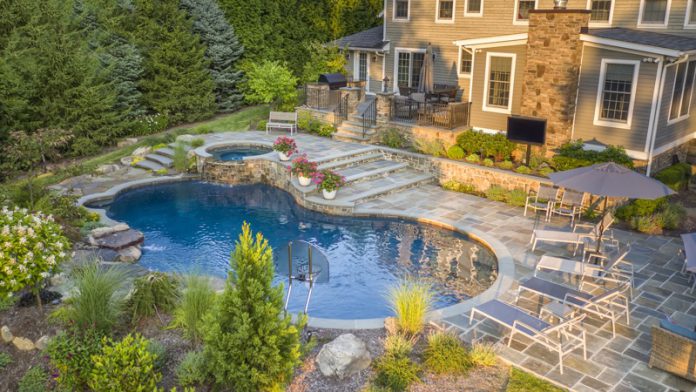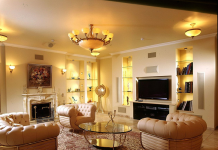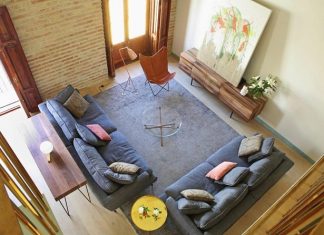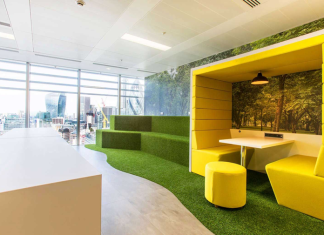Pool hardscaping is a key element in the overall design of your backyard. It’s important to consider how to best integrate this space into the surrounding environment, which includes elements such as plants and water features. In this article, we’ll discuss some principles for balancing nature and design when designing your own pool hardscape.
Introduction to pool hardscaping
Pool hardscaping is a combination of pool design and landscaping. It’s a way to make your pool more comfortable and attractive while also adding more value to your home.
Pool hardscaping involves choosing the right kind of materials for each part of your backyard landscape. You’ll want to consider how you wish to use these materials, as well as what kind of environment they’ll be placed in when finished.
Design principles for balancing nature and design
Balancing nature and design in pool hardscaping requires careful consideration of the surrounding environment and the desired aesthetic. Using these principles, designers can create a hardscape that looks not only beautiful but also feels natural and integrates well with the surrounding landscape. In addition, utilising sustainable design practices, such as using native plants and permeable surfaces, can help create an eco-friendly and low-maintenance hardscape. By following these design principles, designers can achieve a harmonious balance between nature and design in pool hardscaping.
Understanding the site and environment
When designing a pool, it’s important to understand the site and environment. The site will determine where you place your pool and how large it is. It also determines what kind of lighting you can use, whether or not there are trees or shrubs on site, etc. A good rule of thumb is that if you want something done right (like adding a waterfall), then start by doing some research first.
Choosing materials that complement the surroundings
You have to use materials that match the surroundings. The natural environment should be reflected in your design, so you’ll want to select durable, long-lasting materials that can stand up to wear and tear over time. If you’re building a pool with a deck or patio area, make sure the decking and other surfaces are finished with an appropriate material. You should also look for easy maintenance options when choosing a material for your backyard landscaping project. Look for products specifically designed for cleaning pools and consider whether they’re easy enough to clean.
Incorporating greenery into the hardscaping
Incorporating greenery into pool hardscaping is a great way to balance nature and design. Plants, shrubs and trees can bring life and colour to the hardscape and also help to blend it into the surrounding environment. Landscaping elements such as planters, garden beds and hanging baskets can be used to add a pop of colour. Larger trees can provide shade and create a more natural environment.
The use of native plants can help create a low-maintenance and sustainable landscape while also attracting local wildlife. Incorporating greenery into the hardscaping enhances the aesthetic appeal. It also provides numerous environmental benefits, such as reducing heat islands, improving air quality, and conserving natural resources.
Using natural stone and rock features
Natural stone and rock features can add a unique and organic touch to pool hardscaping. They can be used for edging, creating steps or seating areas, or as decorative elements such as rock gardens or waterfalls. Choosing materials that match the surrounding environment, such as local stone or rock, can create a harmonious look. Incorporating these features not only enhances the design but also adds texture and depth to the overall hardscape. The natural variations in colour, shape and texture of stones and rocks can also add interest and make each hardscape truly one-of-a-kind.
Creating a seamless transition between the pool and the landscape
This is essential for achieving a harmonious and cohesive design. This can be accomplished by using similar materials and textures in both the hardscape and the surrounding environment. You can use the same pavers or stones for the pool deck and patio. Softscaping elements such as plants, shrubs and trees can also be used to create a gradual transition between the two spaces.
Integrating the hardscape and landscape through the use of curves, flowing lines, and organic shapes can also help to create a more natural and cohesive look. The use of lighting can also enhance the transition between the pool and the landscape by highlighting key features and creating a welcoming ambience at night. By creating a seamless transition, designers can ensure that the pool and landscape work together to create a harmonious and beautiful outdoor space.
Incorporating water features into the hardscaping
Water features are a great way to enhance the natural beauty of your hardscaping. If you have a large yard, consider placing waterfalls or fountains at their entrance and along the length of their pathway. You can also create a seamless transition between your pool and landscape by adding rocks or stepping stones. This should lead from one area to another, creating an uninterrupted flow from one part of your yard into another.
Finally, water features can work together with outdoor lighting so that when people can enjoy the pool at night as well.
Using lighting to enhance the natural beauty of the hardscaping
Lighting is a natural element of the landscape that can be used to enhance the natural beauty of your hardscaping. It can also create a relaxing atmosphere, dramatic effect, or focal point in your yard.
Lighting is often overlooked when designing landscaping because it’s usually not as visible as other elements, such as plants or flowers. However, it will help bring life to your yard without any added maintenance costs.
Maintenance considerations for pool hardscaping
Maintenance is important to the longevity of your pool. You should consider regular maintenance, including cleaning the pool and equipment, maintaining an optimal environment for aquatic life, maintaining a balanced chemistry in your pool water and more.
Conclusion
Pool hardscaping is an opportunity to blend nature and design to create a beautiful and functional outdoor space. By following the above-mentioned design principles, you can achieve a harmonious balance between nature and design. Whether incorporating natural stone and rock features, greenery, or water features, the end result will be a unique and aesthetically pleasing hardscape. It should also integrate well with the surrounding environment. Through careful consideration and thoughtful design, pool hardscaping can provide a beautiful and functional space.














